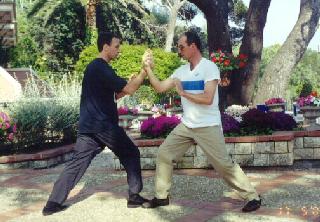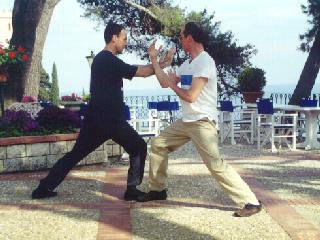CONTINUOUS ATTACKS
(Progressing from Techniques to Tactics in Combat)

Editorial Note: This is originally meant to be a private webpage for students of Shaolin Wahnam Institute. Nevertheless, as there is not much information on Pushing Hands and Striking Hands although they are crucial aspects of Taijiquan, some explanation is given so that other Taijiquan practitioners may also benefit.
In the previous four series, Series 1 to 4, you learned the basic skills and techniques for Pushing Hands. It is useful to note the difference between skills and techniques. A technique is a way of employing a particular stance and a hand movement for attack and defence.
There are, of course, countless ways of employing stances and hand movements for attack and defence. But past masters discovered that certain ways were advantageous in certain situations. For example, past masters discovered that if they wanted to push at an opponent, it would be more advantageous to use a Bow-Arrow Stance than a False-Leg Stance or no proper stances at all. These preferred ways were passed down to us as techniques.
Skills refer to how well you apply techniques. For example, you and a master may use the same technique to push at an opponent, but the master does so more effectively because he has better skills. There are different skills, but the three most fundamental skills in combat are correct form, force and speed.
Yhe four special skills you have developed in the previous four series, and which are particularly important in Taijiquan, are being relaxed, energy flow, flowing with the opponent's movements, and leading the opponent's movements.
In the previous four series, you used only one technique for attack, and only one technique for defence, and they are “an” or “push” and “peng” or “ward off”. We purposefully limit the attack and the defence to only one technique each so that you can fully focus on developing skills.
In the next four series of Pushing Hands, you are introduced to four combat tactics. A tactic is a planned application of techniques in some general ways to secure advantages. For example, in your previous training you pushed at your partner and he warded it off. Then you pushed at him again, and again he warded it off. He could do so because he had both the skills and the technique to defend against your attack.
Now suppose you have put in some thoughts and have come out with a plan. You execute a push, and as expected your partner begins to ward off your attack. But as soon as he defends and before he could recover from his defensive movement, you execute a second push.
If you execute the two pushes continuously you have a better chance of pushing your partner away than if you execute the same two pushes but separated by a break. He fails to defend against your attack not because he does not know the defensive technique, but because you have successfully employed a tactic that has caught him of guard.
The tactic employed here is “Continuous Attacks”, and is demonstrated below by Roberto and Attilio.

Roberto and Attilio are at the "peng" position.

Roberto moves his left back leg to his right front leg, and immediately moves his right front leg foraard, simultaneously pushing Attilio. Attilio moves his right front leg to his left back leg, and immediately moves his left back leg backward to ward off the attack.

But Roberto's first attack is a feint. As soon as Attilio defends against this first attack, Roberto moves forward again with a second attack, pushing Attilio backward.

If you apply this tactic against someone who is not properly trained, you have a good chance to succeed. But if he knows about the tactic and is trained to defend against its application, it is not difficult to neutralize the continuous attacks. Here, as Attilio senses Roberto's second attack, he moves his front leg to his back leg, and his back leg backward, simultanwoudly warding off Roberto's second attack. .
The training sequence for the tactic of confusing attack is shown below.

|

|

|
Training Points
- When applying a tactic, do not neglect your skills and techniques. Remember that you need good skills and good techniques to apply tactics.
- Do not rush into the second attack. Practice slowly but smoothly at first. Speed will follow correct practice.
- You may continue with two, three or more attacks. However, merely attacking continuously is not necessarily an advantage, and may sometimes be exploited by a skilful opponent.
- The example shown here involves frontal attacks. Gradually practice left, right and back attacks, and use different footwork.
- It is not necessary to have the same mode of attacks, like front push followed by
Taijiquan Pushing Hands
-
Series 1 -- Basic Techniques and Skills
-
Series 2 -- Front Attacks and Defence
-
Series 3 -- Right Side Attacks
-
Series 4 -- Left and Back Attacks
-
Series 5 -- Continuous Attacks
-
Series 6 -- Confusing Attacks
-
Series 7 -- Instantaneous Counters
-
Series 8 -- Tactic of Interception
Taijiquan Striking Hands
-
Series 1 -- Basic Striking Attacks and Defence
-
Series 2 -- Seeking Advantages in Striking Attacks
-
Series 3 -- Basic Kicking Attacks and Defence
-
Series 4 -- Seeking Advantages with Kicking Attacks
-
Series 5 -- Felling Attacks and Defence
-
Series 6 -- Reversing Falls
-
Series 7 -- Gripping Techniques
-
Series 8 -- Counters against Gripping Attacks
LINKS
